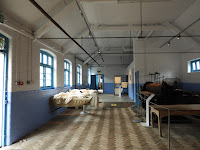I'll start with a brief, lifted, history of Gressenhall:
In 1776 the combined parishes of Mitford and Launditch bought Chapel Farm at Gressenhall to build a ‘house of industry’ for the poor. Conditions were tough, however, poor families were allowed to live together and earn some money from their work.
In 1834 the Poor Law Amendment Act led to the transformation of the house of industry into a workhouse – one of 22 Union Workhouses across Norfolk. The aim was to keep costs low by making life for the paupers so unpleasant that people would do everything they could to avoid having to live there. A new system of classification separated men, women and children. Work included breaking stones, pumping water, carting gravel and oakum picking for men and domestic chores in the kitchens, laundry and female wards for women. The only benefits were the health care and education.
The workhouse finally closed in 1948. After a short period of time as a home for the elderly, Gressenhall Farm and Workhouse opened as a museum in 1976.
The museum is effectively split in two parts. Part one relates to life in the workhouse which could be pretty grim. It was designed to keep the inmates alive, clean and healthy but food was basic in the extreme, days were regimented for all with lights out at 8pm, punishments for breaking rules and and pretty much nothing to look forward to. There was no obligation to stay but if your prospects outside were limited it often amounted to the best option available.
There are various display illustrating life in the house with stories from inmates and those in charge and the old laundry, worked by female inmates, also still exists.




















No comments:
Post a Comment